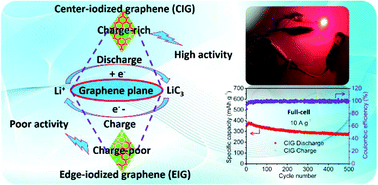Center-iodized graphene as an advanced anode material to significantly boost the performance of lithium-ion batteries†
Abstract
Iodine edge-doped graphene can improve the capacity and stability of lithium-ion batteries (LIBs). Our theoretical calculations indicate that center-iodization can further significantly enhance the anode catalytic process. To experimentally prove the theoretical prediction, iodine-doped graphene materials were prepared by one-pot hydrothermal and ball-milling approaches to realize different doping-sites. Results show that the center-iodinated graphene (CIG) anode exhibits a remarkably high reversible capacity (1121 mA h g−1 after 180 cycles at 0.5 A g−1), long-cycle life (0.01% decay per cycle over 300 cycles at 1 A g−1) and high-rate capacity (374 mA h g−1 after 800 cycles at 8 A g−1), which greatly improves the performance of the edge-iodinated graphene anode and these results are in good agreement with the theoretical analysis. More importantly, the CIG anode also delivers a high-rate capacity and excellent cycling stability (279 mA h g−1 after 500 cycles at 10 A g−1) in full-cells. Both the theoretical analysis and experimental investigation reveal the enhancement mechanism, in which the center-iodization increases the surface charge for fast electron transfer rate, improves the conductivity for charge transport and rationalizes the pore structure for enhanced mass transport and ion insertion/desertion, thus resulting in a high rate capacity and long cycle life. This work not only discloses the critical role of catalytic sites including both amounts and site positions but also offers great potential for high-power rechargeable LIB applications.

- This article is part of the themed collection: Nanoscale 10th Anniversary: Top Authors


 Please wait while we load your content...
Please wait while we load your content...